Schmorl's hernia it is considered a fairly common disease in which the lesion is localized on the spine, provokes various symptoms and can lead to the development of severe complications.
The disease affects patients of different ages, can proceed in an acute and chronic form, and often significantly worsens the condition of patients. For treatment, various methods are used that allow not only to eliminate the symptoms, but also to prevent the progression of the pathology.
Record content:
- 1 What is Schmorl's hernia?
-
2 Hernia sites
- 2.1 Lumbar
- 2.2 Thoracic department
- 2.3 Cervical
- 3 Views by location
- 4 By the way of defeat
- 5 Causes of occurrence
- 6 Stages of hernia development
- 7 Diagnostics
-
8 Treatment methods
- 8.1 Drug therapy
- 8.2 Physiotherapy
- 8.3 Massage
- 8.4 Exercise therapy
- 8.5 Surgery
- 8.6 Other methods
- 9 Possible complications
- 10 Hernia video
What is Schmorl's hernia?
Schmorl's hernia is a degenerative-dystrophic disease of the spinal column, in which there is a protrusion of the cartilaginous tissue of the intervertebral disc in the vertical plane. At the same time, there is an increase in pressure on adjacent vertebrae and a violation of their structure with prolonged persistence of symptoms without special treatment.
The difference between this type of hernia and the classical form is precisely the nature of the protrusion. In a conventional herniated disc, it occurs in the horizontal plane, which leads to displacement of the vertebrae as a result of the gradual destruction of the disc.
Experts note that Schmorl's hernia belongs to hereditary diseases, but often develops in elderly patients.
Hernia sites
Schmorl's hernia on the spine can be localized in its various parts. 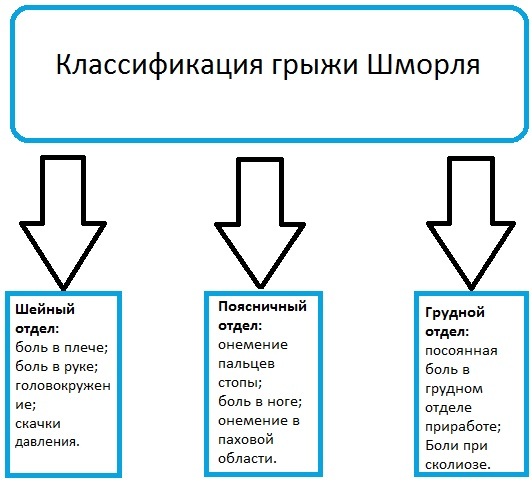 Symptoms and the risk of complications largely depend on the site of the lesion.
Symptoms and the risk of complications largely depend on the site of the lesion.
Lumbar
In the area of the lumbar spine, such a hernia occurs quite often. This is due to the increased load on this particular department, as well as the presence of other degenerative-dystrophic diseases in this area.
Pathology provokes various symptoms depending on the individual characteristics of the patient.
At the initial stages, it does not manifest itself in any way, but as the condition progresses, the following signs appear:
- Pain in the lumbar region, aggravated by heavy exertion or with prolonged presence of the patient in one position. People whose professional activities are associated with constant sitting or standing are more likely to suffer from severe forms of the pathological condition. This is due to the increased load on the lumbar spine.
- Discomfort or pain in the lower extremities. In this case, patients may notice that the pain begins in the spine and gradually reaches the calf muscles.
- Numbness of the legs, crawling on the skin, changes in the state of the skin. These symptoms appear only with prolonged progression of the condition.
- Fatigue and weakness of the leg muscles. If the patient is actively involved in sports, he may notice a decrease in endurance.
- Disorders of the pelvic organs occur at advanced stages, when not only the vertebrae are affected, but also the nerve endings responsible for the innervation of the organs.
Depending on the presence or absence of other complications, patients may experience concomitant manifestations.
Thoracic department
Localization of a hernia in the thoracic spine occurs most often. There is no exact data on the reasons that could explain this, but the lesion can form not only in old age. It is often found in adolescents. At the initial stages, the condition is not disturbed, which is associated with the minimum size of the hernia.
As the condition progresses, the vertebra is destroyed and its pressure on the spinal cord increases. It is at this stage that neurological disorders develop, accompanied by severe pain during exertion and being in one position for a long period of time. Patients report numbness in the hands, muscle pain and fatigue.
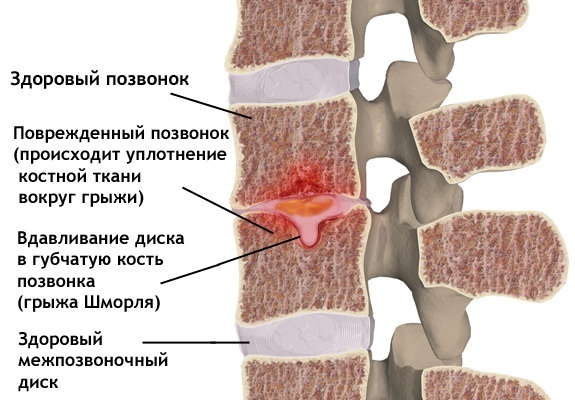
Against the background of damage to the spinal cord in the thoracic spine, the functioning of the chest and abdominal organs may be impaired. Patients can develop various complications. The most pronounced disorder is pain that is localized in the area of the hernia.
Cervical
Localization of the lesion in the cervical spine is not so common. The condition is considered dangerous, since the risk of blocking the artery supplying the brain and the patient's death increases.
Patients with this type of hernia are worried about frequent headaches and dizziness. However, symptoms are not relieved with conventional analgesics. Patients report decreased mental performance, impaired memory and concentration.
The condition is aggravated in the absence of therapy. Patients may develop a stroke, as well as oxygen starvation of tissues as a result of a decrease in the volume of incoming blood.
Views by location
A Schmorl's hernia on the spine can affect various parts of the disc and vertebra. Depending on this, doctors distinguish several types.
| Hernia type | Peculiarities |
| Central | It is localized in the central part of the intervertebral disc, progresses rather slowly, exerts uniform pressure on the adjacent discs. |
| Front | It is rather difficult to diagnose, since the lesion is localized in the anterior part of the intervertebral disc and is poorly visible on x-rays. |
| Side | One of the most common types of hernia, in which the lateral part of the disc is affected, which leads to uneven pressure on the vertebrae. |
| Back | A common type of hernia, accompanied by degenerative-dystrophic disorders in the posterior part of the intervertebral disc. |
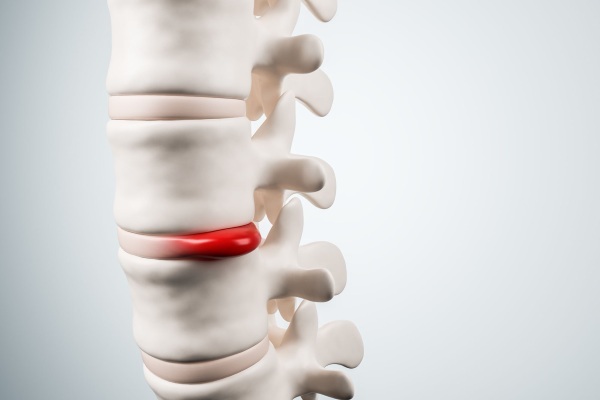
Depending on the localization of the lesion, the symptomatology of the disease and the rate of its progression differ.
By the way of defeat
Depending on the method of lesion of the intervertebral disc, several types of pathological conditions are distinguished. By the number of foci, single and multiple hernias are distinguished. The former are not so common, are not accompanied by pronounced manifestations and can be asymptomatic for a long period of time.
Multiple hernias or nodules are quite common, they affect several vertebrae at once, which complicates the course of the pathology and leads to rapid progression with the development of severe complications.
Doctors distinguish several types of the disease:
- A minor hernia is asymptomatic for a long time.
- Intracorporeal is localized in the region of the central part of the intervertebral disc.
- A deep one affects the vertebrae quite strongly, which leads to compression and the development of severe symptoms.
- A hernia of the endplates can disrupt the location of the vertebrae and impair the functioning of the brain, since it affects the most thinned areas of the vertebra.
- Caudal hernia also affects the thinnest areas of the vertebra, which are destroyed rather quickly, which leads to a significant deterioration in the condition and the development of severe complications.
Symptoms differ slightly depending on the location and method of damage to the vertebrae and discs.
Causes of occurrence
Schmorl's hernia occurs not only as a result of the patient's hereditary predisposition to such a lesion on the spine.
There are other reasons, predisposing factors that can provoke a pathological condition:
- Improper nutrition with insufficient content in products of components that are necessary for the health of cartilage tissue.
- Being overweight, which increases pressure on the intervertebral discs.
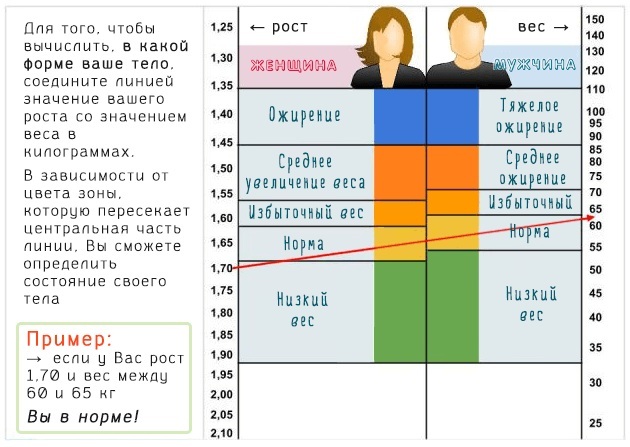
- Intensive growth during adolescence, when bone tissue develops somewhat more slowly, which leads to the formation of voids in the vertebral body. This reason is considered the most common when pathology occurs in patients under 18 years of age.
- Degenerative-dystrophic changes in cartilage tissue as a result of age-related physiological processes in the body of patients.
- Severe injuries of the spinal column, in which deformation of the discs and vertebrae is possible.
- Severe and long-term calcium deficiency in the patient's body, which leads to an increase in bone porosity. Especially often the disease develops in women during menopause, when, as a result of a decrease in estrogen levels, there is an intense leaching of calcium from the bones.
- Professional sports, which involve lifting weights and intense loads that increase the pressure on the spinal column. Pathology can develop in patients who, due to their professional activities, lift weights every day.
- Other diseases of cartilage and bone tissue, such as osteoarthritis. In this case, there is a lesion of the spine, which increases the risk of developing severe complications.
Various predisposing factors can provoke the disease, the degree of its neglect and the rate of progression depend on it.
Stages of hernia development
The development of the pathological condition is carried out over a different period of time, depending on the number of foci, as well as the degree of tissue damage. However, any form of the disease occurs in 3 stages. Only the time required for the transition of the disease from one stage to another differs.
At stage 1, there is no symptomatology. It is possible to determine the presence of the disease only in the case of routine preventive diagnostics of the patient.
If you examine the images, you can see that the fibrous ring of the intervertebral disc is somewhat broken, but it is not completely torn, which explains the absence of symptoms. The condition of patients at this stage does not deteriorate, only a slight decrease in working capacity is possible.
At stage 2, the first symptoms appear, which is associated with further damage to the annulus fibrosus and the progression of the disease. Depending on the localization of the focus, the pain is concentrated mainly in the cervical, thoracic or lumbar region.
Somewhat later, numbness of the extremities, muscle weakening and circulatory disorders join. Typically, at this stage, the patient seeks a doctor for help.
At the 3rd stage, complications from the internal organs appear, the working capacity is significantly reduced, there is a change in the patient's posture.
With the localization of the focus in the cervical spine, headaches become intense and are rather difficult to stop with analgesics. At this stage, complications appear that aggravate the condition and can lead to irreversible changes.
Diagnostics
Schmorl's hernia on the spine is diagnosed quite simply, but doctors always use several methods to assess the general condition of the patient:
- A general and biochemical blood test helps to assess the general condition of the patient and see signs of inflammation, if any. It is considered an important stage in the diagnosis, while examining blood from a vein.
- Examination and questioning of the patient is considered an important stage in the diagnosis. In this case, the doctor not only listens to the patient's complaints, but also assesses the skin, posture and possible negative changes that appear in the form of external signs. Based on the survey and examination data, an additional examination is assigned.
- X-ray of the spinal column in different projections is considered the most effective diagnostic method. Since it helps to identify the degree of tissue damage and the number of foci in the spine. After examining the images, the doctor prescribes additional research and treatment.
- Magnetic resonance imaging of the spinal column is used as an additional diagnostic method. It is prescribed in the case when, when carrying out an X-ray, it does not allow to accurately determine the degree of tissue damage.
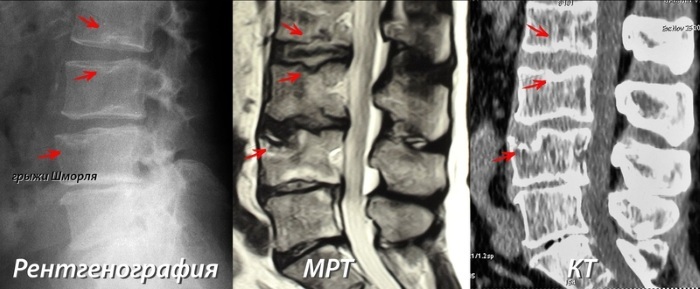
After receiving the results of the diagnosis, the specialist prescribes the appropriate treatment depending on the symptoms and the presence of complications.
Treatment methods
For the treatment of patients, medication and non-medication methods of treatment are used. Usually, the doctor selects drugs and additional methods that enhance the effectiveness of treatment and reduce the risk of complications.
Drug therapy
To alleviate the condition, anti-inflammatory, pain relievers and drugs are prescribed to eliminate tissue swelling.
The most effective remedies:
- Spazmalgon - an antispasmodic medication that helps to significantly improve the condition and relieve spasm of the smooth muscles of the musculoskeletal system. The remedy eliminates pain, is used for exacerbation of the condition. The dosage is determined individually, ranges from 2-4 tablets per day. The treatment lasts 5-7 days.
-
Ketorol - an anesthetic and anti-inflammatory medication that is actively used to eliminate pain and stop the progression of the disease. The drug is taken within 5-7 days, 1-3 tablets per day. If necessary, the course is extended, but only as directed by a doctor.
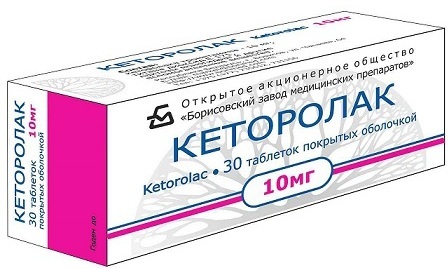
- Ibuprofen has pronounced anti-inflammatory and analgesic properties. It is taken 2-4 tablets per day for 5 days. With pathologies of the digestive tract, it is worth taking the medication with caution.
- L-lysine helps not only to eliminate pain, but also has decongestant properties, which prevents the progression of the disease. The solution is administered intravenously using a dropper, after adding 5-10 ml to 200 ml of sodium chloride. The treatment lasts 10 days with daily manipulations.
- Actovegin improves tissue nutrition and blood circulation in the affected area. The drug is taken in courses of 2-3 weeks, the daily dosage is 3-6 tablets. The drug significantly improves the patient's condition.
- Neuroubin it is prescribed to improve the condition of tissues, contains vitamins of group B. The agent is injected intramuscularly at 3 ml per day for 10 days. If necessary, repeated courses are prescribed every 3-6 months.
- Teraflex contains substances that improve the condition of cartilage tissue. It helps to increase the elasticity of the annulus fibrosus of the disc, stimulates the production of components responsible for cartilage repair, and prevents its rapid destruction. Take 1 tablet 2 times per bitch, treatment lasts at least 6 weeks
Other means are also used if the patient's condition worsens, but in most cases, with the timely initiation of therapy, more potent medications are not required.
Physiotherapy
Schmorl's hernia on the spine can be treated with physiotherapy methods that help to significantly improve the condition of the tissues and stop the progression of the disease. They cannot completely cure the disease, but they reduce the risk of complications.
The most effective method of physiotherapy is electrophoresis. The method consists in attaching special sensors to the skin in the spinal region, which supply low-frequency electrical impulses to the tissues.
These impulses stimulate blood circulation and promote tissue repair. To obtain a therapeutic effect, it is required to undergo at least 10 procedures with a frequency of 3 days.
Massage
Massage is an effective and important stage of rehabilitation after undergoing a course of drug therapy. The procedure should be performed only by a specialist. They last at least 30 minutes and are held once every 2-3 days. The minimum course duration is 15 sessions.
The method helps to improve the condition of tissues, improves blood circulation and stops the progression of the pathological process. Against the background of these changes, an improvement is noted.
Exercise therapy
Physiotherapy exercises are used in the recovery phase after the elimination of acute symptoms with the help of medications. The set of exercises is selected for each patient individually, depending on the condition, localization of the lesion and the presence of accompanying deviations.
Exercises are performed at least 3 times a week. At the initial stages, it is allowed to perform them no more than 10 minutes. As the condition improves, the exercise time increases and gradually reaches 30 minutes. The first few sessions are best done under the guidance of an instructor who will point out possible mistakes and explain precautions.
Surgery
Surgery usually involves replacing the affected vertebra with a titanium implant. It is carried out under general anesthesia and involves a long period of rehabilitation, which includes taking medications, physiotherapy and physiotherapy exercises.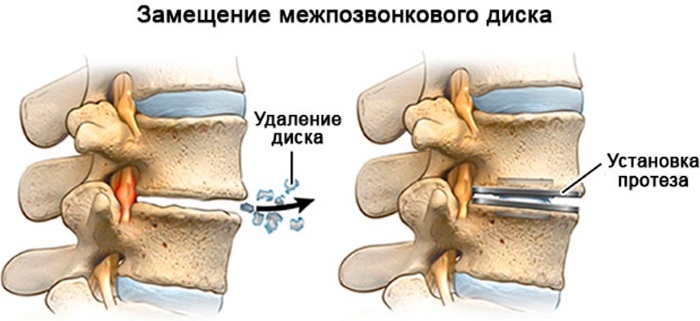
The operation is indicated in case of complete destruction of a vertebra, damage to several vertebrae at the same time, as well as pinching of the spinal cord, in which the functioning of internal organs is impaired. The method of intervention and the characteristics of anesthesia for each patient are determined individually.
Other methods
Additional treatments include acupuncture. This method is not used very often, but it is considered very effective, provided that it is carried out by a specialist.
The procedure involves the introduction of special needles into biologically active points on the patient's back. When they are stimulated, the acceleration of tissue repair processes is observed. The session lasts up to 1 hour, is carried out 2-3 times a week for a month. If necessary, the course is extended up to 2 months.
Possible complications
If left untreated, patients develop complications.
The most common ones are:
- Impaired patient mobility.
- Pathology of internal organs.
- Disorders of the functioning of the pelvic organs.
- Rachiocampsis.
- Displacement of the vertebral discs.
- Complete destruction of the bone tissue of the spine.
- Pinched nerve endings.
The most severe complication is the patient's loss of the ability to move.
Schmorl's hernia is a common disease, localized on the spine, and can provoke severe complications. To prevent the progression of pathologies, it is necessary to visit a doctor in a timely manner and undergo a course of therapy.
Hernia video
Doctor about Schmorl's hernia - causes, symptoms and treatment:



